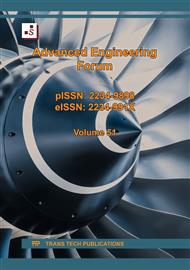[1]
J.L. Borges, A.S. Cardoso, Overall stability of geosynthetic-reinforced embankments on soft soils, Geotext. Geomembr. 20(6) (2002) 395- 421.
DOI: 10.1016/s0266-1144(02)00014-6
Google Scholar
[2]
Technical Guidelines for Design and Construction of Embankment on Soft Ground, China Communications Press: Beijing, China, JTG/T D31-02-2013.
Google Scholar
[3]
R.J. Bathurst, F.M. Naftchali, Geosynthetic reinforcement stiffness for analytical and numerical modelling of reinforced soil structures, Geotextiles and Geomembr. 49(4) (2021) 921–940
DOI: 10.1016/j.geotexmem.2021.01.003
Google Scholar
[4]
H.O. Magnani, M.S.S. Almeida, M. Ehrlich, Behavior of two test embankments on soft clay, Geosynth. Int.16(3) (2009) 127-138.
DOI: 10.1680/gein.2009.16.3.127
Google Scholar
[5]
F. Kasim, A. Marto, B.A. Othman, I. Bakar, M.F. Othman, Simulation of safe height embankment on soft ground using Plaxis, APCBEE Proceedia 5 (2013) 152–156.
DOI: 10.1016/j.apcbee.2013.05.027
Google Scholar
[6]
P.J. Venda Oliveira, L.J.L. Lemos, Numerical analysis of an embankment on soft soils considering large displacements, Comput. Geotech. 38 (2011) 88-93.
DOI: 10.1016/j.compgeo.2010.08.005
Google Scholar
[7]
F. Bourges, C. Mieussens, Déplacements latéraux à proximité des remblais sur sols compressibles, Méthodes de prévision, Bulletin de liaison des L.P.C., Paris, 101 (1979) 73-100.
Google Scholar
[8]
P. Rossi, L. Gavois, G. Raoul, Assises des vallées compressibles : Choix des méthodes de consolidation. Techniques d'Ingénieur, C 5 364 (2007).
DOI: 10.51257/a-v1-c5364
Google Scholar
[9]
T. Tanchaisawat, D.T. Bergado, P. Voottipruex, Numerical simulation and sensitivity analyses of full-scale test embankment with reinforced lightweight geomaterials on soft Bangkok clay, Geotext. Geomembr. 26(6) (2008) 498-511.
DOI: 10.1016/j.geotexmem.2008.05.005
Google Scholar
[10]
D.T. Bergado, C. Teerawattanasuk, 2D and 3D numerical simulations of reinforced embankments on soft ground, Geotext. Geomembr. 26(1) (2008) 39-55.
DOI: 10.1016/j.geotexmem.2007.03.003
Google Scholar
[11]
R.K. Rowe, C. Taechakumthorn, Design of reinforced embankments on soft clay deposits considering the viscosity of both foundation and reinforcement, Geotext. Geomembr. 29(5) (2011) 448-461.
DOI: 10.1016/j.geotexmem.2011.03.001
Google Scholar
[12]
A. Demir, M. Laman, A. Yildiz, M. Ornek, Large scale field tests on geogrid reinforced granular fill underlain by clay soil, Geotext. Geomembr. 38 (2013) 1-15.
DOI: 10.1016/j.geotexmem.2012.05.007
Google Scholar
[13]
J.P. Magnan, Methods to reduce the settlement of embankments on soft clay: a review, ASCE Specialty Conf Settlement 94 on vertical and Horizontal deformations of Foundations and Embankments. College Station, Texas, 1994.
Google Scholar
[14]
S.S. Gue, Y.C. Tan, Geotechnical solutions for high speed track embankment - a brief overview, In:Proc. of the Technical Seminar Talk - Permanent Way Institution Annual Convention Pahang, Malaysia, 2001, pp.1-7.
Google Scholar
[15]
B. Chevalier, Modélisation numérique discrète des renforcements de sols compressibles par inclusions rigides. XXVIème rencontres universitaires de génie civil, France, 2008.
DOI: 10.1080/12795119.2004.9692581
Google Scholar
[16]
K. Deb, S.R. Mohapatra, Analysis of stone column-supported geosynthetic-reinforced embankments, Applied Mathematical Model, 37(5) (2013) 2943–2960
DOI: 10.1016/j.apm.2012.07.002
Google Scholar
[17]
P. Majedi, B. Karimi Ghalehjough, S. Akbulut, S. Çelik, Effect of reinforcement on stability and settlement of embankment: A finite element analysis of different kinds of reinforcing and construction conditions, European Journal of Advances in Eng. and Tech. 4(10) (2017) 759-764.
Google Scholar
[18]
J. Jayapal, K. Rajagopal, Slope stability analysis of embankment resting on granular columns using FEM, Lecture Notes in Civil Eng. 85 (2020) 311–326
DOI: 10.1007/978-981-15-6086-6_25
Google Scholar
[19]
R. Gupta and H. Madupuri, Study of reinforced soil embankment supported on stone column improved ground, Indian Geot. Conf. IGC, Kochi, 2022.
Google Scholar
[20]
R. Zhang, S.R. Lo, Analysis of geosynthetic reinforced stone columns in soft clay, proceedings of the 4th Asian regional conference on geosynthetics, Shanghai, China, 2008, pp.735-740.
DOI: 10.1007/978-3-540-69313-0_134
Google Scholar
[21]
Y.M. Chen, W.P. Cao, R.P. Chen, An experimental investigation of soil arching within basal reinforced and unreinforced piled embankments, Geotext. Geomembr. 26(2) (2008) 164-174.
DOI: 10.1016/j.geotexmem.2007.05.004
Google Scholar
[22]
Z. Yan, Xiaoyan, C.W. Kangyu, A method to analyze the settlement of reinforced piled embankment considering the three-dimensional deformation of geosynthetic reinforced structure, J. Tianjin Univ. Sci. Technol. 52 (2019) 1227–1234.
Google Scholar
[23]
S.W. Abusharar, J.J. Zheng, B.G. Chen, J.H. Yin, A simplified method for analysis of a piled embankment reinforced with geosynthetics, Geotext. Geomembr. 27(1) (2009) 39-52.
DOI: 10.1016/j.geotexmem.2008.05.002
Google Scholar
[24]
X. Cui, W. Zhuang, H. Xiao, J. Zhang, J. Zhang, Investigation on soil arching effect in visual model test of pile-supported embankment, Chin. J. Rock Mech. Eng. 39 (2020) 3150–3158.
Google Scholar
[25]
X. Wang, X. Wang, G. Yang, C. Pu, J. Jin, Field test on deformation characteristics of pile-supported reinforced embankment in soft soil foundation, Sustainability 2022, 14, 7805. https:// doi.org/.
DOI: 10.3390/su14137805
Google Scholar


